Category: Family
Mom’s birthday banquet
I messed up.
A bit of background: On all of my mother’s U.S. government-issued identification — driver license, passport, etc. — her date of birth is listed as September 24, 1946. This is not her birthdate. September 24 is the Gregorian calendar conversion of her actual birthdate, which was on the 24th day of the 9th lunar month. For those unfamiliar, the Chinese calendar is a lunisolar calendar, i.e., it incorporates elements of both lunar and solar calendars. (The only widely used purely lunar calendar is the Islamic calendar, whose year always consists of 12 lunations.) Although the Gregorian calendar is used by Chinese in day-to-day life, the Chinese calendar is firmly entrenched in the culture; it is used to determine the dates for traditional holidays like Chinese New Year and the Mid-Autumn Festival, and in astrology to select auspicious dates for important events like a wedding, a funeral or a business venture. In the Chinese calendar, the first day of the month is determined by the arrival of the new moon. The length of the month will vary between 29 and 30 days.
The Chinese calendar dates do not correspond to the dates on the Gregorian calendar from year to year; Chinese New Year (i.e., first day of the first lunar month) can fall anywhere between January 21 and February 20. In years past, trying to figure out Mom’s birthday would involve tracking down a Chinese calendar, and studying it to determine the date that year. The advent of the Internet has made this annual research somewhat easier, but… well, I’m getting ahead of myself.
The 60th is a milestone birthday in most cultures, so the family wanted to celebrate accordingly. At minimum, this involved the “children” all gathered in one place, which given the geographical distance and punishing work schedules, required quite a bit of advance planning. A few strokes of the keyboard and — Eureka! — I hit upon the official governmental Hong Kong Observatory (HKO) site for handy Gregorian-Lunar conversions — a quick reference to the years from 1901 to 2100. I clicked on 2006 to find the Gregorian calendar date corresponding to the 24th day of the 9th lunar month.
If you looked at the 2006 calendar, you may have noticed, as I did, that the 7th lunar month is repeated: 6th, 7th, 7th, 8th, 9th. I assumed this was an error, so made the adjustment accordingly. The 24/9 (on the calendar as 24/8) would fall on October 15. I sent the word out, and work schedules and tentative celebrations were planned accordingly.
What is the old saw about why one should never ass-u-me?
Had I done a little more research, I would have learned that each lunisolar year has 12 regular months, which are numbered in sequence (1 to 12). However, because a solar year does not have a whole number of lunar months, a lunisolar calendar must have a variable number of months in a year. There needs to be an adjustment every second or third year to keep in sync with the seasons. The adjustment is made in the form of an intercalary or embolismic month — something like a “leap month” — which may come after any regular month. It has the same number as the preceding regular month, but is designated intercalary. For 2006-2007, there are effectively 13 months.
It seems that the Hong Kong Observatory official Gregorian-Lunar calendar was correct in repeating that 7th intercalary month. Mom’s 60th birthday would be on November 14 — not October 15.
So I messed up.
J clued me into this discrepancy when she did her own — accurate — research. Mea culpas (mine) and mad schedule scrambling (theirs) followed, but in the end, since Mom hadn’t wanted an elaborate birthday blowout, I was spared at least from having to recall dozens of mailed invitations — for the second time in two years.
The family plus a few special guests gathered on Saturday night for a traditional Chinese banquet at East Manor in Elmhurst. Longtime friends ML and LL were in town visiting my parents from Vancouver — and also celebrating a birthday — so it became a joint celebration. We made the arrangements in advance, and the restaurant was able to put us in a private curtained area, set off from the fountain wall and familiar-looking ceiling mural. (Egads!)

Food, glorious food. We started off with plates of Chinese cold cuts, bitter melon and jellyfish…
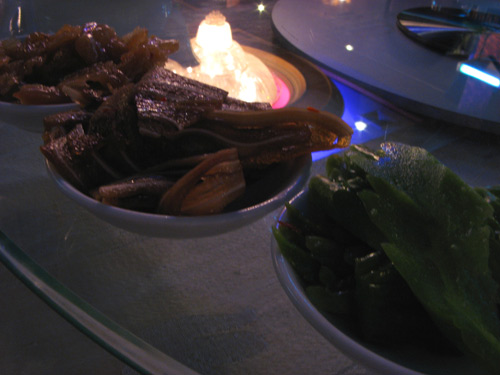
…followed by suckling pig…

… baked scallops on the half shell, with sea cucumber and other seafood…
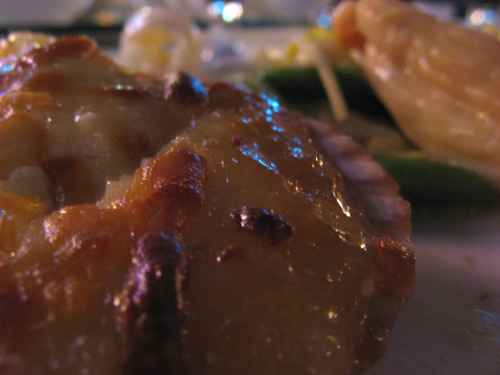
…jumbo prawns (love the candied walnuts!), braised whole abalone with chinese mushrooms, crispy-fried whole chicken, sauteed lobsters, a whole steamed fish, and of course, my favorite: shark fin soup with crab meat.
After all these courses, we finished off the meal with giant platters of E-Fu longevity noodles and a dried fish and scallop fried rice, which was really quite delicious, despite the chef’s sneaky inclusion of golden raisins, which I abhor under almost all circumstances.
Three varieties of sweet dessert soup, and a plate of these lotus seed-paste filled longevity buns — the traditional Chinese birthday bun in the shape of a peach.

Our own Western touch: birthday cake. Well, not entirely Western: it was green-tea flavored.

From now on, I’ve proposed that we celebrate Mom’s birthday on October 18 — which corresponds to the Gregorian calendar date in 1946. Though perhaps we should get second party confirmation on that.
The Good Life
Sunday morning at Williams-Sonoma for Pizza 101 technique class. John was back, demonstrating how to make pizzas from scratch at home, with the caveat that home versions would never be identical to commercial versions, due to the same heat intensity being unattainable by standard residential ovens. Using a pizza stone helps, as the stone’s pores absorb exuding moisture from the dough (for ideally crispy crusts) while distributing heat evenly throughout the pie, minimizing hot spots and increasing the efficiency of the oven. As he started a surprisingly simple pizza dough in the food processor (yeast, sugar, warm water plus flour, salt and extra virgin olive oil), John covered some of the storied history of pizza in America, starting with Gennaro Lombardi’s Spring Street grocery store (later: pizzeria), and his defectors/offshoots: Anthony (Totonno) Pero (of Totonno’s in Coney Island), John Sasso (of Greenwich Village’s John’s Pizzeria), Pasquale “Patsy” Lancieri (of Patsy’s Pizzeria) and Lancieri’s nephew, Patsy Grimaldi (of Brooklyn’s Grimaldi’s Pizzeria). No word on Ray’s.
John demonstrated a classic Pizza Margherita (invented around 1889 and named for the then visiting Queen of Italy, Margherita di Savoia) with diced tomatoes, fresh mozzarella di bufala and chiffonaded basil leaves — representing the red, white and green of the Italian flag. Fifteen minutes out of the oven, and we still had time to make another pie with hot peppers and pepperoni, the most popular topping in the United States.
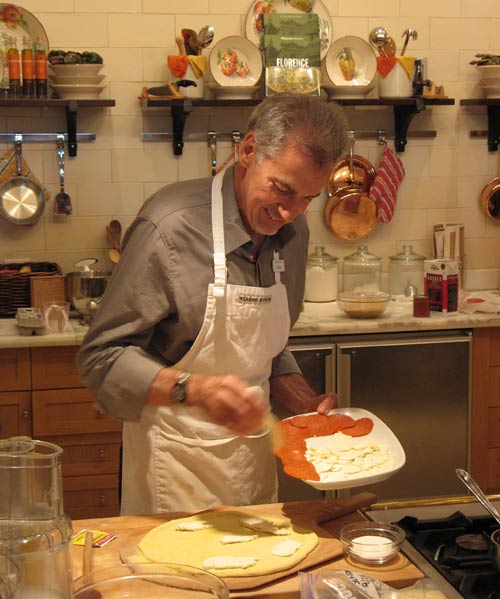
The Van Alen Institute’s “The Good Life: New Public Spaces For Recreation” exhibit was showing at Hudson River Park’s Pier 40. The Downtown Boathouse location here opened for public kayaking on August 19, 2006.


Featured were 70 projects from New York City to London to Rio de Janeiro to Soweto, South Africa — urban projects and existing communal spaces, each selected for its power to redefine public space in the 21st century. Amale Andraos and Dan Wood of WORK Architecture Company transformed the 4500 square foot raw garage space on the southwest corner of the pier into a large-scale exhibit space broken up into smaller spaces by a winding canvas screen, held in place with sandbags. This exhibition was organized around five themes: The 24-Hour City, The Connected City, The Cultured City, The Fun City and The Healthy City. Each “gallery” was set up with video screens and listening stations, explaining the architects’ vision.
“The Good Life” explored both new and currently in development projects on former industrial sites, waterfronts, and reclaimed land, including New York’s Highline and Lincoln Center’s Promenade and West 65th Street Projects.


On Hudson Street, I passed a wall of posters for Lucky Number 6 – which is apparently a perfume being sold at Macy’s:
“Your elegant scent will attract many. For good fortune & happiness, mist on this flower-full blend of harmonious lotus, tiger lily, cashmere woods and jasmine.”
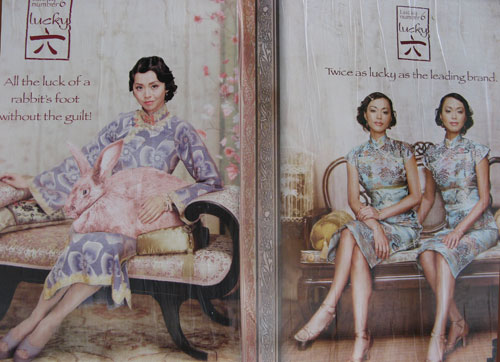
Not sure what to make of the “Shanghai Ladies” aesthetic or the weirdly mystical, fortune cookie-esqe ad copy: “For good fortune & happiness, mist on this flower-full blend” — what the heck?
“Shanghai ladies,” by the way, is not to be confused with “Shanghai women.”

Dinner in Long Island with the family. Peking duck and softshell crab — two of my favorites. Afterwards, we shared cake at J & C’s new — and newly renovated — apartment. Happy birthday, Dad! (One day late.)
Boston markets
It was back to business as usual on Tuesday morning for J & J, but I played hooky for one more day. J chauffeured J and me from Cambridge into the Financial District, during which I got to observe a pretty amusing debate between them on the best strategy for navigating Boston’s infamous traffic-clogged streets. We pulled up in front of J’s building with a few minutes to spare. After dropping off my bags at her office, I set out to tour the area on foot, before three of us were to reconvene for lunch.
The shops were just beginning to open at the markets, and I had most of the area to myself, which really almost never happens in New York City, regardless of the hour. Here, Faneuil Hall with its distinctive gold grasshopper weathervane. The two-story Hall was built in 1740, but rebuilt in 1762 after a catastrophic fire destroyed most of the original structure. Since then it has served as a central location for Boston commerce and meetings, including organized protests against the British prior to the American Revolution, for which the Hall became known as America’s “Cradle of Liberty.” For almost a century, it also served as the chief food supply for Boston, on what was then the edge of Boston Harbor. The water was eventually filled in, and the Quincy Market building was constructed atop its place in 1826, creating much-needed additional commerce space in then rapidly expanding Boston.
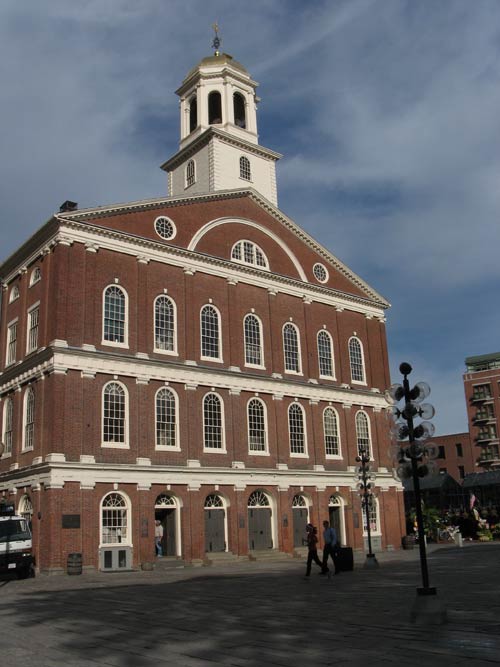
Today, the area which comprises Faneuil Hall, Quincy Market, North Market and South Market is known as Faneuil Hall Marketplace and attracts over 12 million visitors each year. And this summer, 13 of the 120 life-size cows on parade in Boston:
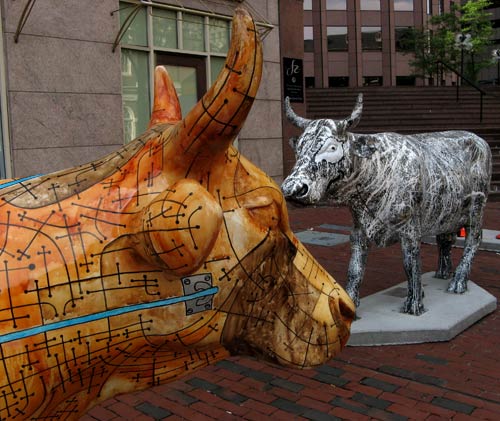

The Market is lined with food stalls, including Boston’s only Beard Papa’s Fresh ‘n Natural Cream Puffs shop. And coming soon: Dale and Thomas Popcorn (ne Popcorn, Indiana), purveyors of my favorite gourmet kettle corn.
Incidentally: the “Quincy” of Quincy Market is Boston mayor and Harvard University president Josiah Quincy III, a descendant of Col. John Quincy, who pronounced his name “quin-zee”, NOT “quin-see.” This same pronunciation applies to the town of Quincy, Massachusetts, and to the sixth president of the United States, John Quincy Adams.
Beneath “Quin-zee” Market’s copper-domed seating area:

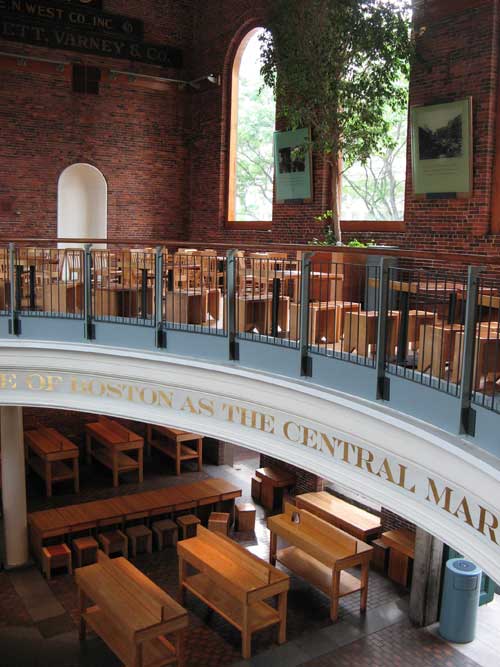
I followed the Freedom Trail up to the North End, past the New England Holocaust Memorial, which was dedicated in October 1995. According to the website, the Memorial features six luminous glass towers, each 54 feet high, set on a black granite path, evocative of the six main Nazi death camps, the six million Jews who died, or a menorah of memorial candles. Smoke rises from charred embers at the bottom of each chamber.

Across the street, the Union Oyster House, the oldest restaurant in Boston and the oldest restaurant in continuous service in the United States.
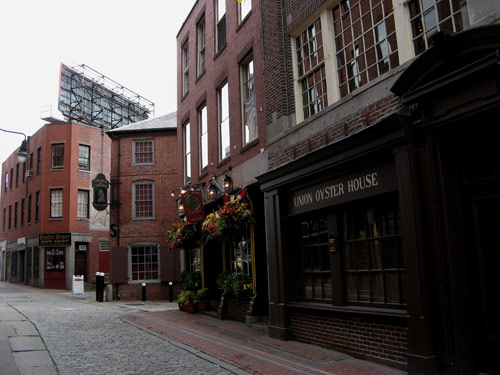

In the North End, I stopped in to tour the four public rooms of the Paul Revere House at 19 North Square, from which he set out on his Longfellow-immortalized Midnight Ride “on the eighteenth of April, in Seventy-five”


The three-story house was already about a century old by the time its most famous resident moved in. It is the only surviving example of 17th century architecture in Boston, and almost all original. Some interesting facts about Revere: he was married twice during his 83 years: first to a woman who passed away shortly after their eighth(!) child was born – I’m conjecturing from exhaustion. Five(!!) months later, he remarried to a woman who bore him another eight(!!!) children. According to my tourguide, though, just 11 of his 16 children survived past infancy, so at any given time, “only” between five and nine children were living under that one roof.
Coffee and sfogliatelle from Mike’s Pastry Shop – at J’s recommendation. (Yum — thanks!)

More cows in Paul Revere Mall:

The Long Wharf in Boston Harbor, once the focal point of Boston’s booming shipping industry.

Our meeting place for lunch: the Flour and Grain Exchange Building (1892) on Milk Street. The impressive, granite building served as the meeting hall for the Boston Chamber of Commerce during its first ten years. Its distinctive conical roof, rounded front masonry and tiered arches made it an easily identifiable landmark for me in the winding streets of Boston’s financial district.

After a quick lunch, J & J accompanied me and my too-heavy bags to South Station, where I hopped the Greyhound bus back to New York City (and to work, *sigh*) Thanks for the hospitality!
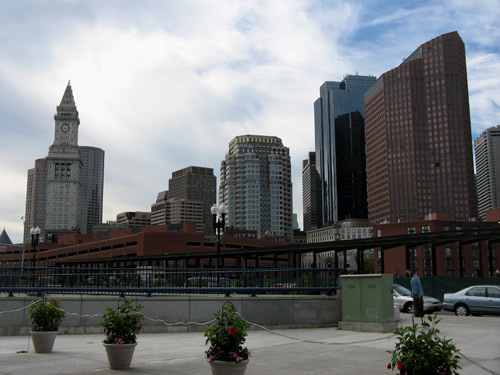
| S | M | T | W | T | F | S |
|---|---|---|---|---|---|---|
| 1 | 2 | 3 | 4 | 5 | 6 | 7 |
| 8 | 9 | 10 | 11 | 12 | 13 | 14 |
| 15 | 16 | 17 | 18 | 19 | 20 | 21 |
| 22 | 23 | 24 | 25 | 26 | 27 | 28 |
| 29 | 30 | 31 | ||||
Search
Popular Tags
Categories
Archive
- July 2010
- July 2009
- January 2009
- November 2008
- September 2008
- August 2008
- July 2008
- June 2008
- May 2008
- April 2008
- March 2008
- February 2008
- January 2008
- December 2007
- November 2007
- October 2007
- September 2007
- August 2007
- July 2007
- June 2007
- May 2007
- April 2007
- March 2007
- February 2007
- January 2007
- December 2006
- November 2006
- October 2006
- September 2006
- August 2006
- July 2006
- June 2006